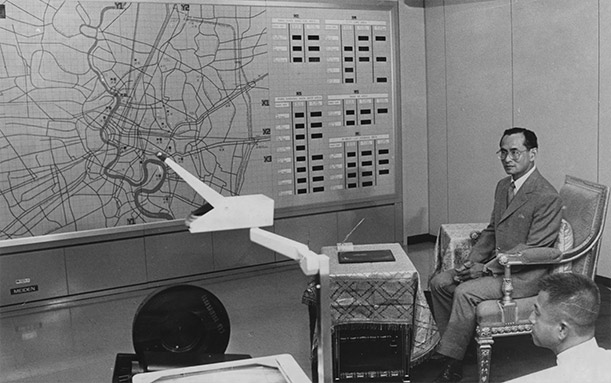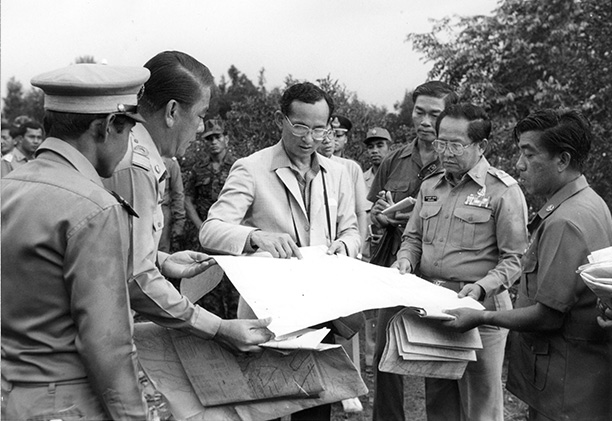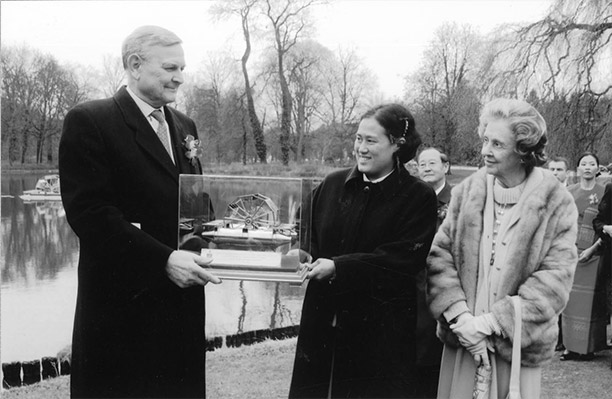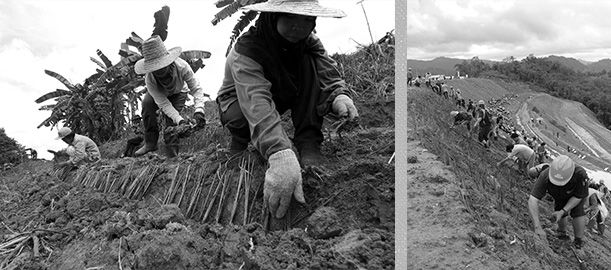Even as a young prince growing up in Switzerland, His Majesty the King was a keen craftsman. With his older brother, King Ananda Mahidol, he assembled electric engines and radios, models and gliders. He even repaired his nanny’s sewing machine and constructed a simple radio.

He embarked on his first degree studies in the field of science but later switched to law and political and social sciences when he acceded to the throne. Despite his huge responsibilities as king, His Majesty has always used his love of science and engineering for the benefit of his people.
In 1955, while flying to visit villagers in the Phuphan Mountainailand, His Majesty noticed that although there were plenty of heavy clouds along his flight path, they failed to bring rainfall to the parched lands below.

His many trips upcountry also informed the King that water scarcity, and the cycle of flooding and drought, had brought extreme hardship to farmers. With no scientific help, they usually relied on supernatural rituals to ask for rain.
To overcome the problems, His Majesty first introduced a concept of check dams that help slow down the flow of water and reduce the risk of flash flood.
Analysing the available scientific data, His Majesty made it known to one of his close aides, MR Debriddhi Devakul, of his firm intention to search for a way to bring down ‘’more rain than that given by nature’’.

The Royal Rain, or artificial rain project, was thus born. The first successful attempt was made in 1969. Further tests helped to refine the technique.
According to His Majesty, artificial rain-making comprises three steps: Triggering, fattening and attacking. Potential rain clouds were seeded, built up, dragged and forced to yield rain with precipitation of a reasonable amount of water over target areas.

In 2003, the European Patent Office granted a patent, numbered EP1491088, to His Majesty the King for “weather modification by royal rainmaking technology”.
Thailand’s help has often been sought by other countries in applying this technology to combat drought.

When Thailand faced severe water pollution problems in the 1990s, His Majesty the King directed his efforts towards ways to solve water pollution as well as waste management and garbage disposal.
The Chaipattana Aerator is possibly the best known of His Majesty’s innovations in this field.
The Chaipattana Aerator is a floating buoy that rotates slowly to pump oxygen into wastewater. The device was first developed to combat water pollution at Wat Bowon Niwetvihara. True to His Majesty the King’s concept of self-reliance, the aerator is a simple and low-cost mechanical device yet works effectively to alleviate problems of wastewater. Not only is it effective in treating polluted water but it also oxygenates water in ponds used for breeding aquatic animals.
The machine is capable of treating water pollution with BOD, or biological oxygen demand, of 250 milligrammes per litre at a rate of 600 cubic metres per day, reducing BOD by more than 90 per cent.
The aerator costs only 96 satang per cubic metre of water treated. In terms of pollutants removed, it can be operated for just 3.84 baht per kilogramme of BOD substances. The device is durable and requires little maintenance.

In 1993, the Chaipattana Aerator Model RX-2 was granted a patent under His Majesty’s name. It was the first patent in the world given to a reigning monarch.
A second patent, numbered 10304, was presented to His Majesty for the Chaipattana Aerator Model RX 5C in 2001.
The Chaipattana Aerator has received several awards including the Golden Invention Award by the Belgian Chamber of Inventors at the Eureka Exhibition in Brussels in 2000 and the Yugoslavia Cup for His Majesty’s ingenuity presented by the Group of Yugoslavia countries.
On April 4, 2003, His Majesty the King presented the Chaipattana Aerator as a gift to the people of Belgium to be installed at Woluwe Saint-Pierre Park, Brussels. Representing His Majesty the King at the handover ceremony was HRH Princess Maha Chakri Sirindhorn, who made the presentation to Her Majesty Queen Fabiola of Belgium.
Another royal initiative to combat soil degradation and erosion was the planting of vetiver grass, known in Thai as ya faek.
As deforestation had caused a vicious cycle of flooding and drought in several areas around the country, soil erosion inevitably ensued. Recognising the problem, His Majesty the King initiated studies and experiments on the use of vetiver grass as a potential solution that is both economical and friendly to the environment.
Unlike most grasses which have roots that spread horizontally, the vetiver has roots which grow downward to a depth of two to four metres. The stems are also very strong. They can withstand heavy flows of water or flooding.
When planted in rows along the side of a mountain, or on road shoulders in the highlands of northern Thailand, they act as a living barrier to prevent soil degradation. As the grass grows, it also helps rehabilitate hard-pan soil.

The research showed that the grass could prevent damage to step terraces and hillside ditches while lessening an accumulation of silt in irrigation and draining canals.
Vetiver’s aromatic root can be used in wardrobes to protect clothing against moth infestation and freshen the air. Its oil is used in fragrances, such as the French perfume Vetiver.
His majesty’s vetiver initiative earned him two prestigious awards in 1993 from the International Erosion Control Association (IECA) and the World Bank.
Other innovations by His Majesty the King include an invention of a computer programme called Phasa Khaek for Devanagari characters which assist students and academics working in this specific field.
The cabinet resolved on May 10, 1994, to declare Feb 2 of every year as Inventor’s Day to commemorate the patent of the Chaipattana Aerator issued to His Majesty the King.
On the auspicious occasion of the 60th anniversary of His Majesty the King’s accession to the throne in 2006, the cabinet also resolved to present His Majesty with the designation of “The Father of Thai Invention”.